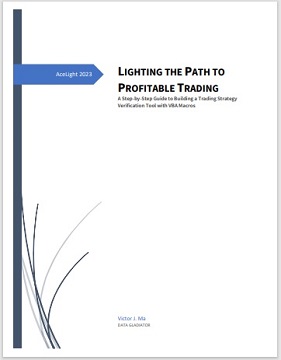Strategies Backtesting:
The Crystal Ball of Stock Trading or a False Sense of Security?
|
|
They say that hindsight is 20/20, but for traders, the real magic is in
backtesting. With the power of historical data and a good backtesting
software, you can test out your wildest trading ideas and see just how well
they would have performed in the past. It's like having a crystal ball, only
instead of predicting the future, it tells you how much money you would have
made if you had a time machine. Who needs a DeLorean when you have a
backtesting platform, right?
To be a successful trader, it is
essential to have a well-thought-out plan that has been thoroughly tested.
One way to do this is through backtesting.
Backtesting is a process
of evaluating a trading strategy using historical data to see how it would
have performed in the past. The objective is to determine whether a trading
strategy is profitable, and how it would perform in different market
conditions. To backtest a strategy, traders will typically use software or
programming languages to run their algorithm on historical data.
To
understand backtesting, traders need to first have a clear understanding of
their trading strategy. This means knowing the entry and exit points, the
risk management plan, and any other rules that govern the strategy. Once
these rules are defined, traders can use historical data to see how the
strategy would have performed in the past.
Here's an example of how
backtesting works:
Let's say you have a trading strategy that
involves buying a stock when it crosses above its 50-day moving average and
selling when it crosses below its 50-day moving average. You want to test
how well this strategy would have performed over the past year.
First, you would need to gather historical data for the stock you want to
test the strategy on. Let's say you choose to test it on Apple (AAPL) stock.
You would need to download the historical price data for AAPL for the past
year, including the opening price, closing price, high and low prices, and
trading volume.
Next, you would need to code your strategy into a
backtesting software program or platform. You would specify the rules of the
strategy, such as the buy and sell signals based on the moving average, as
well as any stop-loss or risk management rules.
Then, you would run
the backtest using the historical data for AAPL. The software would simulate
trades based on your strategy rules and calculate the performance metrics,
such as profit and loss, win rate, and drawdown.
You would then
analyze the results of the backtest to see how well your strategy performed.
You might find that your strategy had a high win rate but suffered from
large drawdowns, or that it performed well in a bull market but poorly in a
bear market.
Based on the results of the backtest, you could then
refine your strategy or decide whether it is suitable for live trading. If
you decide to trade live, you would continue to monitor the performance of
your strategy and make adjustments as needed.
 Backtesting
can be done using a variety of software programs, such as Python, R, and
Excel VBA. Traders will need to import historical data and code their
trading strategy into the software. The software will then simulate trades
based on the strategy rules, and output performance metrics, such as profit
and loss, win rate, and drawdown. For more
information, Click
LIGHTING THE PATH TO PROFITABLE TRADING: A Step-by-Step Guide to Building a Trading Strategy Verification Tool with VBA Macros to get the whole tutorial handbook for free! Backtesting
can be done using a variety of software programs, such as Python, R, and
Excel VBA. Traders will need to import historical data and code their
trading strategy into the software. The software will then simulate trades
based on the strategy rules, and output performance metrics, such as profit
and loss, win rate, and drawdown. For more
information, Click
LIGHTING THE PATH TO PROFITABLE TRADING: A Step-by-Step Guide to Building a Trading Strategy Verification Tool with VBA Macros to get the whole tutorial handbook for free!
And click Free Trial to download strategies testing tools, all for a 30-day Free Trial.
Click on Subscription to order more strategies testing tools to help your stock trading.
The ideal backtesting scenario is when traders have access to
high-quality historical data and are using a strategy that is robust and has
been thoroughly tested. Traders should aim to backtest their strategy over a
long period, ideally several years, to see how it would have performed in
different market conditions.
Traders should also be aware of any
biases that may be present in their data. For example, if a strategy is
tested on data from a bull market, it may not perform as well in a bear
market. To mitigate this, traders should test their strategy on a variety of
market conditions and look for consistency in performance.
Let's say
you have a trading strategy that you want to backtest. You have gathered
high-quality, clean historical data for the instrument(s) you want to trade,
and you have a reliable and accurate backtesting software platform.
You have also taken steps to ensure that your strategy is not overfit to the
historical data. For example, you have used a reasonable number of
parameters and avoided fitting the strategy too closely to the historical
data.
You have also tested your strategy on a variety of market
conditions, including different types of markets (bull, bear, and sideways),
and different timeframes (daily, weekly, and monthly). You have found that
your strategy performs well in a variety of market conditions and is robust
enough to adapt to changes in the market.
You have also evaluated the
performance metrics of your strategy, such as profit and loss, win rate, and
drawdown. You have found that your strategy has a positive expectancy,
meaning that over a large sample of trades, it is expected to generate a
profit.
Finally, you have used the backtesting results to refine your
strategy and make any necessary adjustments. You are confident that your
strategy is ready for live trading and you are prepared to monitor its
performance and make any necessary adjustments as needed.
Overall,
the ideal backtesting scenario involves gathering high-quality data,
avoiding overfitting, testing on a variety of market conditions, evaluating
performance metrics, and using the results to refine the strategy for live
trading.
The downside of backtesting is that it is not a guarantee of
future performance. Just because a strategy has performed well in the past,
it does not mean it will continue to do so in the future. Also, backtesting
relies on the accuracy and completeness of the historical data used. Traders
need to be careful not to overfit their model to historical data, as this
can lead to poor performance in live trading.
Let's say you have
developed a trading strategy that has performed well in backtesting using
historical data. You decide to trade live with the strategy and find that it
is not performing as well as you had hoped. You may be surprised and
frustrated by this, wondering why the strategy that worked so well in
backtesting is failing in live trading.
This is a common pitfall of
backtesting known as overfitting. Overfitting occurs when a strategy is too
complex and has been optimized for historical data, but does not perform
well in live trading. This can happen if a trader tries to fit a strategy
too closely to the historical data, making it less adaptable to different
market conditions.
For example, a trader may optimize their strategy
using historical data from a bull market, but when a bear market occurs, the
strategy does not perform well. The trader may not have anticipated this,
leading to poor performance in live trading.
To avoid this pitfall,
traders should be careful not to overfit their strategy to historical data.
They should also test their strategy on a variety of market conditions and
look for consistency in performance before trading live. It's important to
remember that backtesting is not a guarantee of future performance and
traders should be prepared to adapt their strategy as needed.
Another
pitfall is survivorship bias. Traders need to be aware that historical data
may not include stocks or assets that no longer exist. This can skew
performance metrics and lead to an overestimation of the strategy's
profitability.
In conclusion, backtesting is a valuable tool for
traders looking to develop and test their trading strategies. However,
traders need to be aware of the limitations of backtesting and the potential
pitfalls. By carefully designing and testing their strategies, traders can
increase their chances of success in live trading.
So, as tempting as
it may be to rely solely on backtesting, it's important to remember that
past performance is not always indicative of future results. Don't put all
your eggs in the backtesting basket, or you might end up with a frittata
instead of an omelet.
In the end, the stock market is a fickle
paramour, and no amount of backtesting can guarantee success. But hey, at
least you'll have some pretty charts and graphs to show off at your next
trading club meeting. And who knows, maybe one day you'll be the proud owner
of a real-life DeLorean, trading your way to the future while leaving the
past behind. Good luck, and may the backtesting gods be ever in your favor!
|


|

Free Tutorial
Share
|
|
|
|